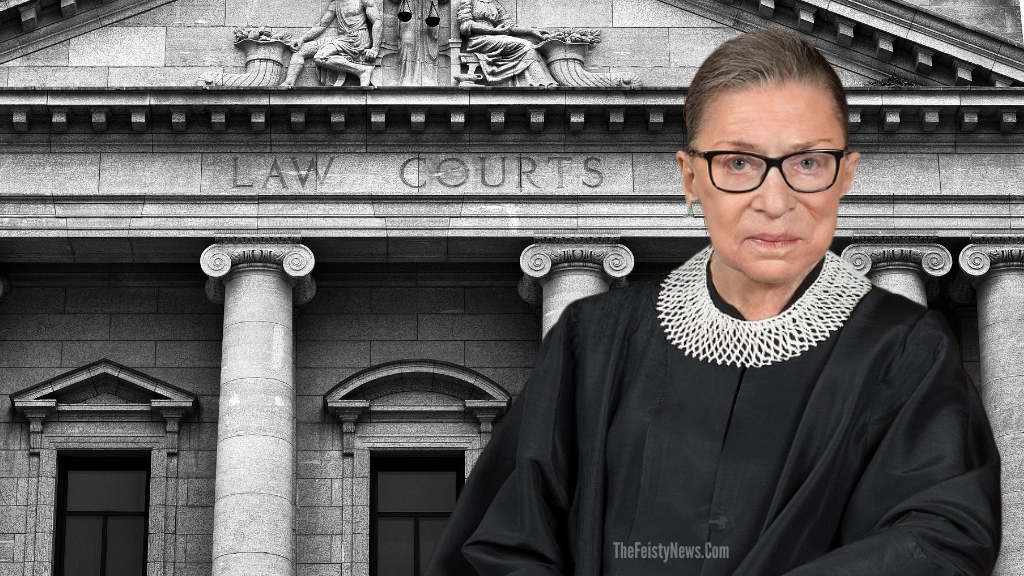Justice Ruth Bader Ginsburg, a late Supreme Court luminary, has recently become the epicenter of diverse opinions, critiques, and cultural commentaries. However, a closer examination of her leadership and tenure reveals a Justice who was not only groundbreaking but also deeply principled.
A Progressive Vision Through Conservative Reasoning
One of Ginsburg’s most unique attributes, as highlighted by Kimberly Wehle in Politico, was her ability to employ conservative reasoning to advocate for progressive causes. This strategic approach allowed Ginsburg to bridge divides and appeal to a broader spectrum of jurists and legal thinkers. Her restrained and fair-minded approach to law showcased a Justice who was deeply respectful of the Constitution and its foundational principles. Far from being a mere ideologue, Ginsburg’s moderate to conservative stances on certain issues, like criminal and business law, demonstrated her commitment to objective legal interpretation.
Justice Ruth Bader Ginsburg’s jurisprudential approach often defied easy categorization. Her brilliance lay not just in her unwavering commitment to progressive causes but also in her methodical and sometimes conservative legal reasoning to achieve those ends. This approach set her apart from many of her peers and demonstrated a deep respect for the rule of law.
Kimberly Wehle, in her Politico piece, underscores Ginsburg’s use of conservative principles in service of liberal causes. One of the hallmarks of Ginsburg’s jurisprudence was her application of the 14th Amendment to the Constitution, which prohibits the government from denying equal protection of the laws. Ginsburg championed the interpretation of this amendment to counteract arbitrary laws based on gender. While the amendment itself does not explicitly mention gender, Ginsburg’s arguments were rooted in a conservative belief: that laws should not be arbitrary or discriminatory in their application.
Ginsburg’s approach to legal reasoning also exemplified her belief in the importance of procedure, federalism principles, and judicial independence. For instance, even when advocating for causes like women’s rights or gender equality, she consistently maintained that the government should not exert arbitrary power over its citizens. This adherence to principles typically associated with conservative jurisprudence showed that Ginsburg was not merely an activist judge but a jurist dedicated to a fair and consistent application of the law.
Furthermore, Ginsburg’s perspective on judicial interpretation demonstrated a nuanced balance. She defied the popular dichotomy that paints “good” judges as those sticking strictly to the Constitution’s language and “bad” judges as those treating the document as a blank slate. Ginsburg’s ability to apply conservative analytic principles to politically liberal causes showcased her depth of understanding and commitment to the integrity of legal interpretation.
In essence, Justice Ginsburg’s progressive vision was not a product of mere ideological fervor. It was a calculated, deeply principled approach that married conservative legal reasoning with a passion for justice and equality.

Trailblazing Achievements
Ginsburg’s unparalleled achievements in the legal realm cannot be overstated. As Emily Dai notes, Ginsburg’s early career was marked by a series of firsts: she was among the few women accepted into Harvard Law School, became the first woman to work on the law reviews at both Harvard and Columbia Law Schools, and was the second woman to serve on the Supreme Court. Her pioneering work in women’s rights and gender discrimination laws has left an indelible mark on American jurisprudence.
Justice Ruth Bader Ginsburg’s career stands as a beacon of perseverance, brilliance, and dedication to breaking barriers. Her legacy is replete with pioneering achievements, each marking significant milestones not only for women in the legal profession but for American jurisprudence as a whole.
Emily Dai’s emphasis on Ginsburg’s early achievements draws attention to the formidable challenges Ginsburg faced in a predominantly male-dominated legal arena. One of the few women accepted into Harvard Law School, Ginsburg’s admission was an early testament to her determination and exceptional prowess in the field. However, her achievements at Harvard went beyond mere attendance. She became the first woman to work at the prestigious Harvard Law Review, an honor reserved for the top legal minds.
Upon transferring to Columbia Law School due to family reasons, Ginsburg continued her streak of excellence. There, she achieved the rare distinction of working at the law reviews of both Harvard and Columbia Law Schools, demonstrating her unparalleled legal acumen and work ethic.
Beyond academia, Ginsburg’s legal career was marked by a series of significant contributions to the fight against gender discrimination. As the co-founder of the Women’s Rights Project at the American Civil Liberties Union, Ginsburg was instrumental in changing the legal landscape concerning women’s rights. Notably, her arguments in Reed v. Reed paved the way for legal challenges against gender discrimination. This case, where she successfully argued against arbitrary gender-based discrimination in estate matters, set a precedent that would be invoked in numerous subsequent cases.
Furthermore, her opinion in United States v. Virginia stands as a testament to her commitment to gender equality. In this landmark case, Ginsburg wrote the majority opinion that struck down the male-only admission policy of the Virginia Military Institute, reinforcing the principle that state-sponsored institutions cannot discriminate based on gender without a compelling reason.
Ginsburg’s trailblazing journey culminated in her appointment to the Supreme Court, making her only the second woman to serve on the nation’s highest bench. Her tenure on the Supreme Court further solidified her legacy as a fierce advocate for justice, equality, and the rule of law.
Beyond the Cult of Personality
While Mari Uyehara’s piece in The Nation critiques the cult-like status Ginsburg has achieved, it’s crucial to differentiate between the popular culture representation and the person. Ginsburg’s pop culture status, although extensive, should not eclipse her genuine contributions to law and justice. The elevation of her persona in media, from Saturday Night Live sketches to operas, is a testament to her broad appeal and influence. However, Ginsburg’s real legacy lies in her consistent fight for justice, equality, and the rule of law.
In the modern era of media saturation, few Supreme Court Justices have achieved the iconic cultural status that Justice Ruth Bader Ginsburg enjoyed. However, to truly appreciate Ginsburg’s legacy, it is essential to differentiate between the media’s portrayal and the substance of her contributions to law and justice.
Mari Uyehara’s article in The Nation touches upon the cult-like adoration that Ginsburg garnered over the years. This pop culture phenomenon, characterized by Saturday Night Live sketches, operas, and an expansive array of Ginsburg-themed merchandise, is a testament to her broad appeal and the deep resonance of her work with the public. While such recognition undoubtedly speaks to Ginsburg’s influence, it also risks simplifying her nuanced and multifaceted legacy into digestible soundbites and catchy slogans.
However, a deep dive into Ginsburg’s career reveals a jurist whose impact extended far beyond her popular “Notorious RBG” persona. As the co-founder of the Women’s Rights Project at the American Civil Liberties Union, Ginsburg’s legal acumen and strategic brilliance played a pivotal role in reshaping gender discrimination laws in the United States. Cases like Reed v. Reed and her opinion in United States v. Virginia were not merely legal victories but foundational shifts in American jurisprudence.
Yet, the narrative that elevates Ginsburg as the primary dissenter sometimes obscures the contributions of other active dissenters on the bench. While Ginsburg’s dissents, particularly in high-profile cases, have been celebrated, it’s essential to recognize her body of work holistically, rather than focusing solely on a handful of decisions.
Furthermore, Uyehara rightly points out that Ginsburg’s life possesses a cinematic allure. However, it’s crucial to remember that while Ginsburg’s journey was undoubtedly trailblazing, the legal landscape was also shaped by other influential figures, like Pauli Murray, a brilliant black female lawyer whose work has often been overshadowed.
Facing Criticisms Head-On
Justice Ruth Bader Ginsburg, like all prominent public figures, was no stranger to criticism. However, what sets her apart is her ability to address these criticisms directly, with both grace and conviction, and continue her unwavering commitment to the principles of justice.
One of the most significant criticisms levied against Ginsburg, particularly in her later years, was her decision not to step down from the Supreme Court during President Obama’s tenure. Critics, including Emily Dai, argued that by not retiring at a time when a like-minded successor could have been confirmed, Ginsburg potentially jeopardized the rights she had long championed, given the unpredictability of future political landscapes. This criticism gains weight in the context of the Supreme Court’s role as a pivotal institution that can shape American policy and rights for generations.
Yet, Ginsburg’s response to such critiques showcased her commitment and belief in her role. She often stated that she would continue to serve “as long as I can do the job full steam.” This sentiment wasn’t merely a reflection of personal ambition but rather a testament to her dedication to the Court and the American people. Ginsburg believed in the resilience of the judicial system and its ability to withstand transient political pressures.
Furthermore, while Ginsburg’s progressive stances on women’s rights and gender equality are well-celebrated, her record on other issues, such as criminal justice, has faced scrutiny. Some critics have pointed to her law-and-order streak, suggesting a mixed record. However, Ginsburg’s decisions in these areas reflect a nuanced understanding of the law, where she often sought a balance between individual rights and societal needs.
It’s also worth noting that while Ginsburg’s pop culture status elevated her to an almost infallible icon in the eyes of many, she never shied away from acknowledging her own fallibility. She was open to discussions, debates, and even reconsidering her own stances when presented with compelling arguments.
Justice Ruth Bader Ginsburg’s legacy is an intricate blend of groundbreaking achievements, principled legal interpretation, cultural influence, and resilience in the face of criticism. Her journey, from being one of the few women at Harvard Law School to her influential tenure on the U.S. Supreme Court, is a testament to her dedication, brilliance, and unwavering commitment to justice.
She was open to discussions, debates, and even reconsidering her own stances when presented with compelling arguments.
Her ability to utilize conservative reasoning to champion progressive causes showcased not only her strategic brilliance but also her deep respect for the rule of law. It’s a testament to her belief that justice isn’t achieved merely through radical shifts but often through thoughtful and reasoned evolution.
While Ginsburg’s cultural iconography, ranging from Saturday Night Live sketches to operas, speaks to her broader societal impact, it’s essential to pierce through this veneer to appreciate the depth of her contributions to American jurisprudence. The legal landscape she helped shape, from gender equality to the principles of federalism, will continue to influence American society for generations.
However, like all influential figures, Ginsburg’s journey wasn’t without its share of criticisms. Yet, her ability to address, confront, and often learn from these critiques exemplifies her strength of character. It speaks to a leader who was not merely content with accolades but was genuinely committed to the principles of justice, even when they demanded personal introspection.
In an era of fleeting trends and transient loyalties, Justice Ginsburg stands out as a beacon of consistency, dedication, and unwavering commitment to the ideals she believed in. While debates about her decisions, cultural status, and legacy will continue, what remains undeniable is her profound impact on American law and society. Her legacy serves as a reminder that true leadership often lies in the nuanced intersections of conviction, strategy, and an unwavering commitment to justice.
Contributed by Min Hwan Ahn
Min Hwan Ahn is an attorney and owner of the Law Office of Ahn & Sinowitz, located in Pennsylvania. He provides particular expertise in immigration law but also service in various other legal areas. You can explore more about his services by visiting his website EZ485.com.
Author Profile
Latest Entries
 SportsSeptember 30, 2023Nevin seeks to build on her promise with Leicester City – FTBL | The home of football in Australia – The Women’s Game
SportsSeptember 30, 2023Nevin seeks to build on her promise with Leicester City – FTBL | The home of football in Australia – The Women’s Game Women's RightsSeptember 30, 2023Experts back decriminalization as the best means to enhance sex workers’ rights
Women's RightsSeptember 30, 2023Experts back decriminalization as the best means to enhance sex workers’ rights  World NewsSeptember 30, 2023What risks do China’s shadow banks pose to the economy? | Business and Economy
World NewsSeptember 30, 2023What risks do China’s shadow banks pose to the economy? | Business and Economy LifestyleSeptember 30, 2023Costco has begun selling gold bars
LifestyleSeptember 30, 2023Costco has begun selling gold bars



.jpeg)


